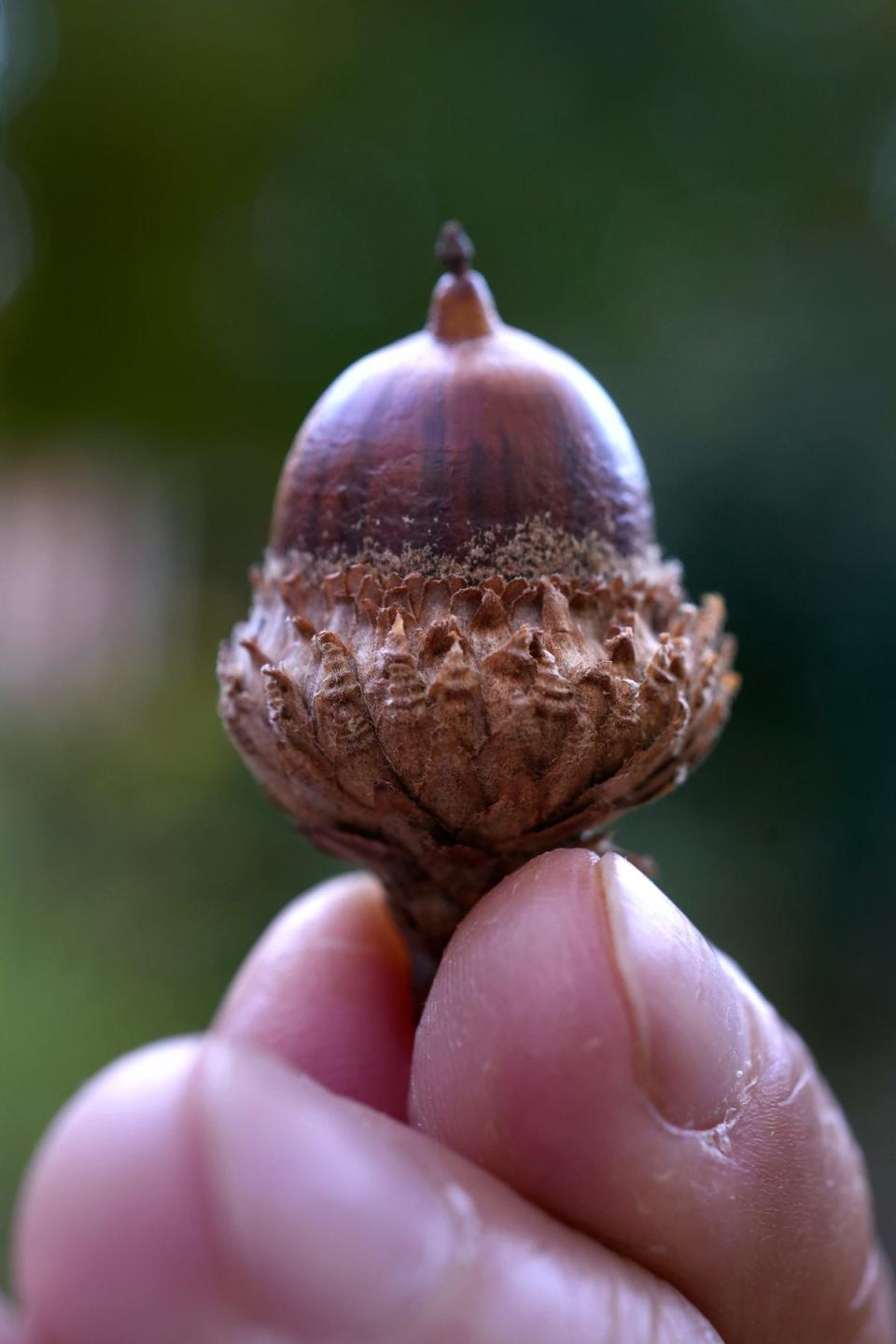Maybe you’ve been plonked on the head one too many times while out in the woods. Or you’ve come across a patch of forest floor that made it feel like you were walking on marbles.
If either of these things has happened to you in recent weeks, then you may have noticed a proliferation of acorns around these parts this fall, evidence of what scientists say appears to be what’s known as a mast year for certain species of oak.
What is an oak tree mast year?
There are different types of oak trees, and they don’t all follow the same schedule for acorn production. While trees may drop at least small amounts every one or two years, bigger crops are more irregular. So even though you may come across acorns every year, that has more to do with the variety of different oaks that grow locally and their staggered production.
Related types loosely follow their own singular cycles.
Most species in the red oak family may generate big numbers of acorns every four years or so.
Varieties of white oak may do so every three years.
For the black oak – a member of the red oak group – it can be every other year. Every so often, their cycles may even line up, leading to extra-large bumper crops.
This seems to be the year for Northern red oaks, black oaks and their relatives, which are some of the most common oak species found in Rhode Island and the rest of the Northeast – trees that grow not only in city parks and far-flung natural refuges but also along our streets and in our backyards.
“I’m ankle-deep in acorns in my own yard,” said Fern Graves, forest stewardship program coordinator with the Rhode Island Department of Environmental Management. “I guess if you’re a squirrel, that’s a good thing.”

The most productive tree in North American forests
But if you’re not, all those acorns can be annoying.
Combine them with the leathery, slow-to-decompose leaves that cascade down from oaks each autumn and you may start to wonder whether these trees are worth all the trouble of cleaning up after them.
Don’t. They are.
Oaks provide copious shade in the summer, sequester large amounts of carbon, enrich the soil, and allow rain to percolate into the ground through their vast root systems rather than causing runoff.
They also offer a majestic presence on the landscape. If you’re in doubt, check out the towering white oak on Birch Swamp Road in Warren that grew from an acorn that germinated around the time the Pilgrims arrived in the New World. Or another with branches that sweep the ground in McCulloch Field at St. Andrews Farm in Barrington that may also date back more than 300 years.

Then there’s the critical role oak trees play in the larger ecosystem. University of Delaware entomologist Douglas Tallamy describes in his 2021 book “The Nature of Oaks” how the 91 species in their genus in North America host more than 950 types of moth and butterfly caterpillars, more than double the number for birches and five times that of elms. Parent cardinals, wrens, warblers and many other songbirds depend on those caterpillars to raise their young each spring and summer.
And, of course, all the acorns in the fall are another vital source of calorie-rich nutrition for all sorts of different animals in the region as the weather cools, days grow shorter and other foods become scarcer, from blue jays and wild turkeys to racoons, bears and deer, opossums and squirrels. (They’re not found around here, but acorn woodpeckers in California even create specialized tree-borne granaries that they stock with their finds to get them through the colder months.)
Throw in the many ground-dwelling insects and beneficial organisms that reside in the leaf litter of oaks and there’s good reason why Tallamy devoted an entire book to trees that he says “support more forms of life” than any other in North America.
“There is much going on in your yard that would not be going if you didn’t have one or more oak trees gracing your piece of planet earth,” he writes.
What drives a mast year for oak trees?
So what drives the boom-and-bust cycles of acorn production?
The prevailing theory, known as “predator satiation,” is that the big crops of acorns in mast years are aimed at overwhelming the appetites of the animals that feed on them. Simply put, a few lean years of acorn production will help keep predator populations down, so that during a mast year, when there’s an explosion of acorns, the chances will be greater that some will go uneaten and grow into seedlings.
That probably wouldn’t work if a single tree acted independently. But if all oaks in a group of species work together and synchronize production, then it becomes an effective strategy for successful reproduction.

Like so much about oak masting, how individual trees line up their timing is a mystery. It may be as straightforward as the trees responding to the same environmental cues. Or, as some scientists posit, trees may be communicating through airborne chemical signals.
Production cycles are also influenced by other factors. Pestilence, for one. The spongy moth infestation between 2015 and 2017 in the southern and western parts of Rhode Island would have kept acorn numbers down simply by killing off thousands of oaks. As for the trees that were defoliated but survived the moth’s ravenous caterpillars, they wouldn’t have had the energy to produce big numbers of acorns for some time.
Weather is the other big determinant. A wet spring can create the right conditions for the blooming of many oak flowers, known as catkins and coons, a good sign of higher acorn numbers. On the flipside, a dry summer can tamp down acorn maturation.
The latter seems to be what happened in 2022, when the state was hit by a drought that the National Oceanic and Atmospheric Administration described as “historic.” And last year, a late spring frost that struck when oaks had just started flowering may have combined with drought conditions to inhibit acorn production.
As for the conditions this year, they’ve been nearly ideal.
“We had low insect pest pressure, excellent weather for pollination when the oaks were blooming, and plenty of rain over the summer to support the developing acorns,” said Rebecca Nelson Brown, chair of the University of Rhode Island’s Department of Plant Sciences and Entomology. “The oaks are taking advantage of that and producing a heavy crop.”
A big year for trees in the red oak family
All told, North America’s oak trees collectively produce more nuts than all the other nut trees on the continent.
It takes about 20 to 30 years for an oak to mature to the point at which it starts producing acorns. And once it does, it can generate 10,000 in a year. The total over a lifetime could be as high as 3 million, according to Tallamy.
Acorn production can vary widely from tree to tree, even those of the same species. A mature yard tree that’s cared for and dominates the canopy is more likely to drop a lot of acorns than a younger tree competing for light and nutrients in a forest.

Mast years can be hard to pin down because they’re often based on subjective observations. But bolstering the case that this is one for red oaks are data from the Connecticut Agricultural Extension Station, which annually monitors acorn production from 575 trees in the red oak and white oak groups at 12 locations in that state.
In September, 87% of trees in the red oak family were documented with acorns, compared to a historical average of 57%. In contrast, only 9% of trees in the white oak family were found to have acorns, way below the historical average of 25%.
The last big crops of acorns from red oaks were in 2019 and 2016, while there hasn’t been one since 2015 for white oaks, according to the station.
Don’t be surprised if the acorns that have been falling the past few weeks aren’t being gobbled up immediately. Acorns from red oaks have higher levels of tannins, giving them a bitter taste. So while animals will take care of acorns from white oaks in relatively short order, this fall’s acorns may stay on the ground for a little longer.
A few rounds of being soaked by rains and drying out again should help leach out the tannins, said Brett Still, an ecologist who directs the master of environmental science and management program at URI. Deer and other animals will eventually turn to the acorns as winter sets in.
“When they’re desperate enough,” Still said. “In some of these more harsh winters, when you have these heavy mast years, it can help animal populations get through the tough times.”
An uncertain future for oaks
Before the first Europeans arrived centuries ago, three out of every four trees in the region were oaks, said the DEM’s Graves.
Huge numbers were felled to make way for agriculture, as the percentage of land covered by forest in what would become Rhode Island plummeted from an estimated 95% in the early 1600s to a low of just 24% in the mid-1800s.
Farming eventually shifted west to more fertile land, the Industrial Revolution pulled many Rhode Islanders away from agriculture, and forest cover started creeping up again in the state. It now stands at around 50 percent.
There are far fewer oaks today than there used to be – red maples, eastern white pines and sweet birches are now the most common species in Rhode Island – but when you consider their volume, accounting for their size and how much space they occupy, white, red and black oaks are still the dominant trees on the landscape.
Whether they will remain that way is hard to predict. Oak numbers have dropped around the country because of land-clearing, the suppression of wildfires that has allowed other less fire-tolerant species to proliferate, and an increase in numbers of deer, which not only eat acorns but graze on saplings. The percentage of oaks in Eastern forests has been cut in half, according to Tallamy.
Climate change could also force a shift in tree species. Drought contributed to the death of many oaks hit by the spongy moth infestation in Rhode Island, adding another level of stress to trees that were already on the brink. Summers are growing hotter and drier, threatening species that rely on moister soil such as the Northern red oak.
But white oaks and other oak varieties are expected to fare better. As a hedge, scientists at the DEM and URI have planted some southern types of oak as part of an experiment in a state-owned patch of forest decimated by caterpillars in Richmond. Early signs are that the new plantings are doing well, said Christopher Riely, a forestry specialist and research associate at URI who’s co-leading the study.
He too has noticed the increase in acorn numbers on his walks in the woods. They’re a timely reminder of the power of oaks, he said.
“It does really underscore just how important they are to the ecosystem,” Riely said.
This article originally appeared on The Providence Journal: Is this a mast year for oak trees? What experts are saying.
EMEA Tribune is not involved in this news article, it is taken from our partners and or from the News Agencies. Copyright and Credit go to the News Agencies, email news@emeatribune.com Follow our WhatsApp verified Channel




